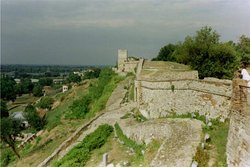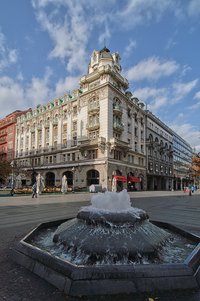Belgrade
|
|
- For other uses, see Belgrade (disambiguation).
Belgrade (Serbian, Београд, Beograd Template:Audio), is the capital (2003–) of Serbia and Montenegro and Yugoslavia (1918–2003). The city lies on the outfall of the Sava river to the Danube river in northern central Serbia, at 44.83° N 20.50° E. Population in Belgrade region 1,711,800 (2002 census.) Template:Infobox Serbia
| Contents |
History
For a quick overview of its history see Timeline of Belgrade
Where the Vinca culture existed and dominated the Balkans about 8000 years ago, Belgrade counts as the one of the oldest European and maybe world cities. Settled in the 3rd century BC by the Celtic before becoming the Roman settlement of Singidunum, the site passed to the Eastern Roman or Byzantine Empire.
Singidunum experienced occupation by successive invaders of the region - Huns, Sarmatians, Ostrogoths and Avars - before the arrival of the Serbs around 630 AD. In 878 the city was renamed Beligrad ("white fortress" or "white town") under the rule of the Bulgarian kingdom.Note:Belgrade could also mean "East Town"couse of the slavic word "Beli" means "east" too. It passed again through Byzantine and Bulgarian rule before emerging as a city of the medieval Serbian kingdom.
The first Serbian king to rule Belgrade was Dragutin (1276-1282), who received it as a present from the Hungarian king.
Belgrade was subsequently occupied by the Kingdom of Hungary, whose forces under John Hunyadi defended it in the siege of Nándorfehérvár of 1456. In 1521, the fort was captured by the Ottoman Turks, and Belgrade remained under Ottoman rule for nearly three centuries. Thrice occupied by Austria (1688-1690, 1717-1739, 1789-1791), the city was briefly held (1806-1813) by Serbian forces during the first national uprising against Ottoman rule, and in 1817 became the capital of an autonomous principality of Serbia (except in the period from 1818-1839, when Kragujevac was the country's capital city).
With the departure of its Turkish garrison (1867) and Serbia's full independence (1878) and elevation to a kingdom (1882), Belgrade became a key city of the Balkans. But despite the opening of a railway to Niš, Serbia's second city, conditions in Serbia as a whole remained those of an overwhelmingly agrarian country, and in 1900 the capital had only 69,000 inhabitants.
After occupation by Austro-Hungarian and German troops in 1915-1918 during World War I, Belgrade experienced faster growth and significant modernisation as the capital of the new Kingdom of Yugoslavia during the 1920s and 1930s, growing in population to 239,000 by 1931 with the incorporation of the northern suburb of Zemun, formerly on the Austro-Hungarian bank of the river.
On April 6, 1941, Belgrade was heavily bombed by the Luftwaffe (killing thousands of people) and Yugoslavia was invaded by German, Italian, Hungarian and Bulgarian forces. City remained under German occupation until October 20, 1944, when it was liberated by Yugoslav Partisan forces and the Red Army. In the post-war period Belgrade grew rapidly as the capital of the renewed Yugoslavia, developing as a major industrial centre. Sarajevo was a short period of time considered as a candidate for the capital.
In March 1972, Belgrade was at the centre of the last major outbreak of smallpox in Europe. The epidemic, which was contained with enforced quarantine and mass vaccination, was over by late May. See: 1972 outbreak of smallpox in Yugoslavia.
On March 9, 1991 massive demonstrations were held against Slobodan Milosevic in the city. Two people were killed and tanks were deployed in the streets in order to restore order. After elections in 2000 Belgrade was the site of major demonstrations which caused the ousting of president Slobodan Milošević.
Belgrade was bombed by NATO aviation during the Kosovo War in 1999 which caused substantial damage.NATO_Damage_to_Belgrade_Defence_Ministry.jpg
Belgrade was under some form of attack some 54 times since AD 1, or every 37 years on average. This means that, statistically, every citizen of Belgrade has seen two attacks on the city in his/her life. Zoran Djindjic was the first elected mayor of Belgrade. The current mayor is Nenad Bogdanovic.
Geography
Belgrade is in northern central Serbia, on the outfall of the Sava river to the Danube, surrounded from three sides by autonomous province of Vojvodina. Old part of city with the Kalemegdan fortress is on a rock ridge between Sava and Danube, directly at the outfall and was thereby protected by three sides. The center of Belgrade lies on the right bank of Danube, and on the left bank begins Banat plain with not too dense inhabited suburbs. Between Danube and Sava is the new city Novi Beograd and a bit upstream of Danube lies Zemun, in the times of the Turkish wars a Habsburg outpost and today a part of Belgrade.
Climate
The climate of Belgrade is very varied. In the winter a very cold wind, the Kosava, blows from the northeast, which lets the blood in the veins freeze even if the thermometer indicates only few degrees under the freezing point. On the other hand, the summer is usually very hot, with temperatures sometimes over forty degrees Celsius. The most pleasant months are May, September and October. But it seems that Belgraders fall in love with their city, and hold that these most diverse variations make the most beautiful city in the world.
Municipalities
There are 17 municipalities, 10 urban and 7 suburban.
Opstinebgd.gif
- Barajevo
- Vodovac
- Vračar
- Grocka
- Zvezdara
- Zemun
- Lazarevac
- Mladenovac
- Novi Beograd
- Obrenovac
- Palilula
- Rakovica
- Savski Venac
- Sopot
- Stari Grad
- Surčin
- Čukarica
Urban municipalities:
Čukarica,
Novi Beograd,
Palilula,
Rakovica,
Savski Venac,
Stari Grad,
Voždovac,
Vračar,
Zemun,
Zvezdara,
Suburban municipalities:
Barajevo,
Grocka,
Lazarevac,
Mladenovac,
Obrenovac,
Sopot,
Surčin,
Architecture
Various parts of Belgrade have wildly varying architecture, from the center of Zemun, which is a typical one for a Vojvodina town, via still remaining Turkish-styled buildings and street layout of the centre of Belgrade, to modern architecture and layout of Novi Beograd.
Some distinctive buildings in Belgrade are:
SvetiSavaBeograd.jpg
- Avala TV Tower
- Bajrakli mosque
- Beli Dvor
- Beogradjanka
- Parliament of Serbia and Montenegro
- Temple of Saint Sava
- Genex Tower
- Palace Albania
- Princess Ljubica's Residence
- Prince Milos's Residence
- Usce Tower - Formerly housed the Central Committee of the Communist Party of Yugoslavia. Since the Nato bombing, which only the skeleton of the building survived, it has been redeveloped into a office block.
Some notable streets and squares are:
- Boulevard of King Alexander (formerly Boulevard of the Revolution) - the longest street in Belgrade
- Knez Mihajlova
- Skadarlija
- Slavija
- Terazije
- Republic Square (square of Victory, of Theater)
- Mitrovic passage - the shortest street in Belgrade
Famous tourist and historical sites from Belgrade include the Avala mountain, the Kalemegdan, the Dedinje ward and the Tito's mausoleum, called Kuća cveća (The House of Flowers).
Museums
Some of the more prominent museums in Belgrade are:
- National Museum (Trg Republike 1a) - An art museum with a collection of over 300,000 objects. Established in 1844.
- Museum of Natural History - has more than 900.000 items related to nature.
- Museum of Contemporary Art (Usce bb) - Includes works of art produced in Yugoslavia since 1900, around 8540 objects.
- Etnographic Museum of Serbia (Studentski Trg 13) - Museum contains more than 160,000 items presenting rural and urban culture of the Balkans. Established in 1901.
- Nikola Tesla Museum (Krunska 52) - Museum preserves personal items of Nikola Tesla. Includes around 160,000 original documents and around 5,700 other items. Established in 1952.
Names
Following is a list of names of Belgrade through history:
| Name | Explanation |
|---|---|
| Singidūn(on) | so named by the Celtic tribe of the Scordisci; dūn(on) means 'lodgment, enclosure', Singi is still unexplained but there are some theories; 279 BC |
| Singidūnum | Romans latinized Celtic name |
| Beograd | Slavic name; first mentioning in 878 in the letter of Pope John VIII to Boris of Bulgaria |
| Alba Graeca | translation in Latin |
| Fehérvár | translation in Hungarian |
| Weissenburg | translation in German |
| Castelbianco | translation in Italian |
| Nandoralba | In medieval Hungary since XIV century |
| Nandorfehérvár | In medieval Hungary |
| Landorfehérvár | In medieval Hungary |
| Veligradon | Byzantine |
| Veligradi, Βελιγράδι | Greek |
| Dar Ul Jihad (The House of War) | Turkish |
| Veligrada | Ottoman |
| Belogrados poleos |
Sports
- From September 15 to September 25 2005, Belgrade will host finals of European Basketball Championships (http://www.ep2005.co.yu). In addition, Serbian cities of Novi Sad and Vrsac, and Montenegrin capital Podgorica will host preliminary competitions.
- Belgrade will be the host city of the 2009 Summer Universiade.
Received Decorations
Belgrade has very important domestic and international decorations.
Twin cities
Belgrade is twinned with the following cities:
- Chicago, Illinois, United States. Since 2005.
Miscellaneous articles
See also
External links
- City of Belgrade (http://www.beograd.org.yu/cms/view.php?id=220)
- Tourist organisation of Belgrade (http://www.tob.co.yu)
- Interactive map of Belgrade (http://www.planplus.co.yu/s/bg.asp)
- Architecture of Belgrade (http://web.mit.edu/most/www/ser/Belgrade/architecture.html)
- Summer Universiade Belgrade 2009 (http://www.universiade-belgrade2009.org/)
- Totally Belgrade (http://www.totallybelgrade.com/) tourist information
- Belgrade Photo Gallery (http://zivotic.com/photo/top.asp?G=Beograd)
- Eurobasket 2005 Belgrade (http://www.ep2005.co.yu)
- Belgrade inside out (http://www.belgradeinsideout.com/) Belgrade information
Quotations
- I cometh and found the noblest burgh from ancient times, the grand town of Belgrade, by sorry fate destroyed and nearly void. Having rebuilt it, I consecrated it to the Holy Mother of God. - despot Stefan Lazarevic
- Soldiers! Heroes! The supreme command has erased our regiment from its records. Our regiment is sacrificed for King and Fatherland. You no longer have to worry for your lives which do not exist. So, forward to glory! Long live the king! Long live Belgrade! - major Dragutin Gavrilovic, to defenders of Belgrade in First World War
| | Missing image Srcoa.gif Flag of Serbia |
|---|---|
|
North Bačka | South Bačka | West Bačka | North Banat | Central Banat | South Banat | Bor | Braničevo | Jablanica | Kolubara | Kosovo | Kosovo-Pomoravlje | Kosovska Mitrovica | Mačva | Moravica | Niava | Pčinja | Peć | Pirot | Podunavlje | Pomoravlje | Prizren | Raka | Rasina | Srem | umadija | Toplica | Zaječar | Zlatibor | |
|
City of Belgrade | |
bs:Beograd da:Beograd de:Belgrad es:Belgrado eo:Beogrado fr:Belgrade ko:베오그라드 hr:Beograd id:Belgrad it:Belgrado he:בלגרד mt:Belgrad nl:Belgrado ja:ベオグラード no:Beograd pl:Belgrad pt:Belgrado ro:Belgrad ru:Белград sl:Beograd fi:Belgrad sr:Београд sv:Belgrad



